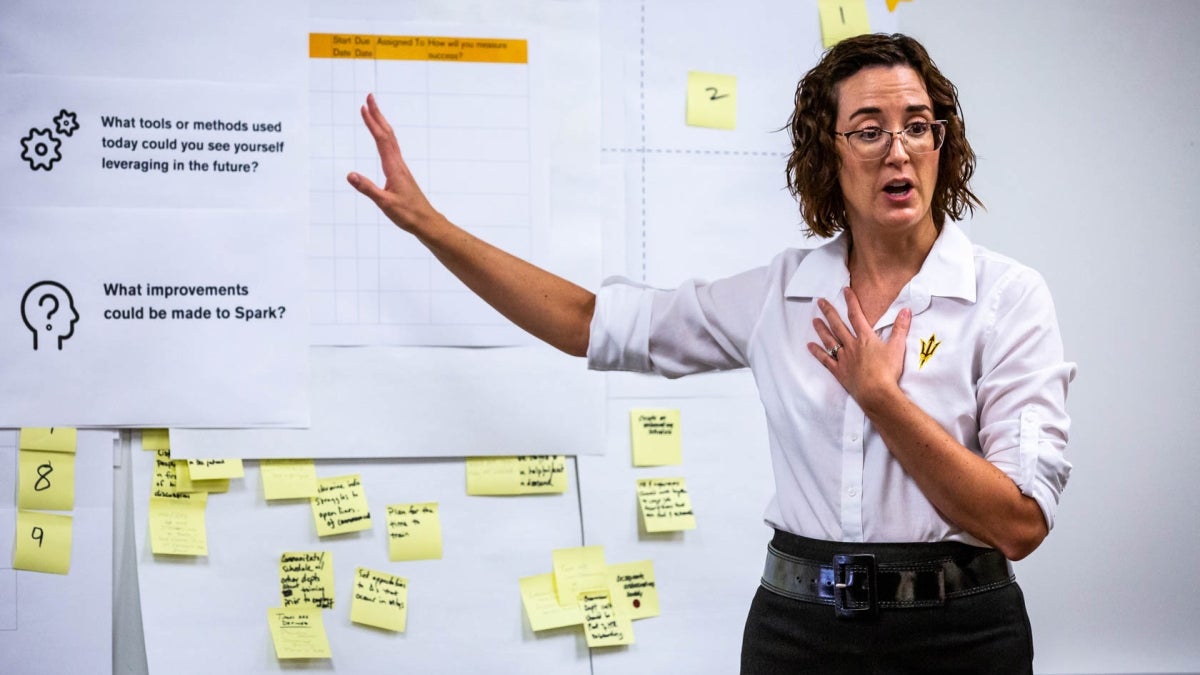Innovative brainstorming method created by ASU staff for staff expands to public

Arizona State University has created its own method for empowering employees to find innovative solutions, and the results have been so successful, the training is now available to anyone, including students and those outside the ASU community.
Starting in the spring semester, students can take a one-credit course in the ASU Spark Method through University College. And people outside ASU can take a professional-development certification course online. The next session begins Jan. 11.
The ASU Spark Method, developed in 2018, is a conversational design tool that’s not only intended to encourage brainstorming and ideation from every team member, but also work through the tangled issues of how to throw away processes that don’t work and start a new way forward.
Signing up for a Spark session indicates that a team is ready to devote time to improvement. The two- to three-hour sessions are focused on empathy and equity – everyone’s input is valued.
Several units at ASU have used the Spark Method to work through difficult problems by analyzing current procedures, finding the bottlenecks and creating an action plan. Human Resources used the method to create a new employee-onboarding system. Spark Method training was also used to streamline curriculum development, create a database project and plan marketing for sustainability events.
The Spark Method was working, but there was no formal way to engage beyond teams of ASU employees, said Anca Castillo, University Design and Innovation Fellow and one of the Spark Method creators.
Last year, the team participated in Idea Enterprise, a high-level process to advance the best ideas created at ASU.
“They said we have something really unique that goes beyond higher education and is of high value,” Castillo said.
The result is that the team decided to launch a Spark Method certificate, in which anyone can become a certified trainer by taking a five-hour synchronous online course and completing a project. Also, the team trademarked the name and patented the Spark Kit materials.
“It’s a tool that we’re providing to the world through our facilitator training, and now we have a concrete path forward for people to engage and become certified,” Castillo said.
This year, the ASU Council of Presidents participated in a Spark Method session, where they worked through the logistics of creating priority items. The Council of Presidents consists of the student body presidents from the Polytechnic, Downtown Phoenix, West and Tempe campuses plus the president of the Graduate and Professional Student Association.
“Through the use of the Spark Method, we were able to explore the ways in which we could accomplish our priorities on a broad scale,” said Cecilia Alcantar-Chavez, president at the Polytechnic campus. “We spoke about the barriers that we face in the creation and implementation of our priority items, as well as addressed the ways we can better inform the student population of progress on our priority items.
“I think that the Spark Method is a great way to get different people together to thoroughly discuss a topic — whether it's a brainstorming session or problem solving for either a broad or a very specific problem.”
The Spark Method team has worked with several external clients, including the Tempe Leadership nonprofit, which went through the process to brainstorm ways to support local businesses.
ASU Spark Method has also gone global, teaching 150 young people in the Young Southeast Asian Leaders Initiative to be facilitators, Castillo said.
The team presented the concept at the National Consortium for Continuous Change and Improvement, which draws universities that are working on best practices of transformation. That led to a group of employees from Yale University becoming trained.
While anyone can become a trainer, the Spark Method team still offers sessions to ASU and external teams.
When the Spark Method workshops started in 2018, all the sessions and training were done in person. Cary Lopez, one of the creators, wasn’t sure that it would ever work digitally. Then the pandemic hit.
“Going digital, we found that it’s even stronger,” said Lopez, who is director of strategic initiatives for the University Design Institute at ASU.
“Even in an international context, it allows for cultural sensitivity and power distancing – the ability of people to voice opposition in front of their superiors. There’s an equalizer in the digital mode that we weren’t able to capture in the in-person method.”
Castillo said that before the virtual sessions, “We were limited in who could participate based on who could be in a room together. Now people can cross the world to participate, and that increases the viewpoints and diversity.”
The Spark Method is rare in that it’s a staff-driven innovation that has been scaled beyond ASU.
“It’s not faculty-driven or research-driven,” Lopez said.
“This was by staff for staff innovating within ASU and now going outside of ASU,” she said.
“It’s a story about the innovative mindset living within all members of the ASU community.”
Top photo: Cary Lopez, one of the Spark Method creators, leads a 2019 session. Now, students can take a one-credit course in the Spark Method and anyone can become a certified Spark Method trainer through an online certification. Photo by Ken Fagan/ASU News